#how to start a wordpress blog in 2020
Explore tagged Tumblr posts
Text
Linkrot
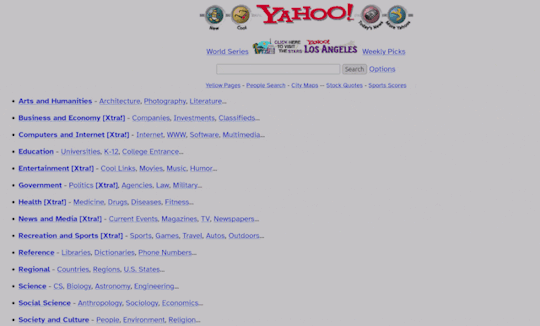
For the rest of May, my bestselling solarpunk utopian novel THE LOST CAUSE (2023) is available as a $2.99, DRM-free ebook!

Here's an underrated cognitive virtue: "object permanence" – that is, remembering how you perceived something previously. As Riley Quinn often reminds us, the left is the ideology of object permanence – to be a leftist is to hate and mistrust the CIA even when they're tormenting Trump for a brief instant, or to remember that it was once possible for a working person to support their family with their wages:
https://pluralistic.net/2023/10/27/six-sells/#youre-holding-it-wrong
The thing is, object permanence is hard. Life comes at you quickly. It's very hard to remember facts, and the order in which those facts arrived – it's even harder to remember how you felt about those facts in the moment.
This is where blogging comes in – for me, at least. Back in 1997, Scott Edelman – editor of Science Fiction Age – asked me to take over the back page of the magazine by writing up ten links of interest for the nascent web. I wrote that column until the spring of 2000, then, in early 2001, Mark Frauenfelder asked me to guest-edit Boing Boing, whereupon the tempo of my web-logging went daily. I kept that up on Boing Boing for more than 19 years, writing about 54,000 posts. In February, 2020, I started Pluralistic.net, my solo project, a kind of blog/newsletter, and in the four-plus years since, I've written about 1,200 editions containing between one and twelve posts each.
This gigantic corpus of everything I ever considered to be noteworthy is immensely valuable to me. The act of taking notes in public is a powerful discipline: rather than jotting cryptic notes to myself in a commonplace book, I publish those notes for strangers. This imposes a rigor on the note-taking that makes those notes far more useful to me in years to come.
Better still: public note-taking is powerfully mnemonic. The things I've taken notes on form a kind of supersaturated solution of story ideas, essay ideas, speech ideas, and more, and periodically two or more of these fragments will glom together, nucleate, and a fully-formed work will crystallize out of the solution.
Then, the fact that all these fragments are also database entries – contained in the back-end of a WordPress installation that I can run complex queries on – comes into play, letting me swiftly and reliably confirm my memories of these long-gone phenomena. Inevitably, these queries turn up material that I've totally forgotten, and these make the result even richer, like adding homemade stock to a stew to bring out a rich and complicated flavor. Better still, many of these posts have been annotated by readers with supplemental materials or vigorous objections.
I call this all "The Memex Method" and it lets me write a lot (I wrote nine books during lockdown, as I used work to distract me from anxiety – something I stumbled into through a lifetime of chronic pain management):
https://pluralistic.net/2021/05/09/the-memex-method/
Back in 2013, I started a new daily Boing Boing feature: "This Day In Blogging History," wherein I would look at the archive of posts for that day one, five and ten years previously:
https://boingboing.net/2013/06/24/this-day-in-blogging-history.html
With Pluralistic, I turned this into a daily newsletter feature, now stretching back to twenty, fifteen, ten, five and one year ago. Here's today's:
https://pluralistic.net/2024/05/21/noway-back-machine/#retro
This is a tremendous adjunct to the Memex Method. It's a structured way to review everything I've ever thought about, in five-year increments, every single day. I liken this to working dough, where there's stuff at the edges getting dried out and crumbly, and so your fold it all back into the middle. All these old fragments naturally slip out of your thoughts and understanding, but you can revive their centrality by briefly paying attention to them for a few minutes every day.
This structured daily review is a wonderful way to maintain object permanence, reviewing your attitudes and beliefs over time. It's also a way to understand the long-forgotten origins of issues that are central to you today. Yesterday, I was reminded that I started thinking about automotive Right to Repair 15 years ago:
https://www.eff.org/deeplinks/2009/05/right-repair-law-pro
Given that we're still fighting over this, that's some important perspective, a reminder of the likely timescales involved in more recent issues where I feel like little progress is being made.
Remember when we all got pissed off because the mustache-twirling evil CEO of Warners, David Zaslav, was shredding highly anticipated TV shows and movies prior to their release to get a tax-credit? Turns out that we started getting angry about this stuff twenty years ago, when Michael Eisner did it to Michael Moore's "Fahrenheit 911":
https://www.nytimes.com/2004/05/05/us/disney-is-blocking-distribution-of-film-that-criticizes-bush.html
It's not just object permanence: this daily spelunk through my old records is also a way to continuously and methodically sound the web for linkrot: when old links go bad. Over the past five years, I've noticed a very sharp increase in linkrot, and even worse, in the odious practice of spammers taking over my dead friends' former blogs and turning them into AI spam-farms:
https://www.wired.com/story/confessions-of-an-ai-clickbait-kingpin/
The good people at the Pew Research Center have just released a careful, quantitative study of linkrot that confirms – and exceeds – my worst suspicions about the decay of the web:
https://www.pewresearch.org/data-labs/2024/05/17/when-online-content-disappears/
The headline finding from "When Online Content Disappears" is that 38% of the web of 2013 is gone today. Wikipedia references are especially hard-hit, with 23% of news links missing and 21% of government websites gone. The majority of Wikipedia entries have at least one broken link in their reference sections. Twitter is another industrial-scale oubliette: a fifth of English tweets disappear within a matter of months; for Turkish and Arabic tweets, it's 40%.
Thankfully, someone has plugged the web's memory-hole. Since 2001, the Internet Archive's Wayback Machine has allowed web users to see captures of web-pages, tracking their changes over time. I was at the Wayback Machine's launch party, and right away, I could see its value. Today, I make extensive use of Wayback Machine captures for my "This Day In History" posts, and when I find dead links on the web.
The Wayback Machine went public in 2001, but Archive founder Brewster Kahle started scraping the web in 1996. Today's post graphic – a modified Yahoo homepage from October 17, 1996 – is the oldest Yahoo capture on the Wayback Machine:
https://web.archive.org/web/19960501000000*/yahoo.com
Remember that the next time someone tells you that we must stamp out web-scraping for one reason or another. There are plenty of ugly ways to use scraping (looking at you, Clearview AI) that we should ban, but scraping itself is very good:
https://pluralistic.net/2023/09/17/how-to-think-about-scraping/
And so is the Internet Archive, which makes the legal threats it faces today all the more frightening. Lawsuits brought by the Big Five publishers and Big Three labels will, if successful, snuff out the Internet Archive altogether, and with it, the Wayback Machine – the only record we have of our ephemeral internet:
https://blog.archive.org/2024/04/19/internet-archive-stands-firm-on-library-digital-rights-in-final-brief-of-hachette-v-internet-archive-lawsuit/
Libraries burn. The Internet Archive may seem like a sturdy and eternal repository for our collective object permanence about the internet, but it is very fragile, and could disappear like that.

If you'd like an essay-formatted version of this post to read or share, here's a link to it on pluralistic.net, my surveillance-free, ad-free, tracker-free blog:
https://pluralistic.net/2024/05/21/noway-back-machine/#pew-pew-pew
279 notes
·
View notes
Text
Ok I am getting asked several times a day about this so I am going to break this down into steps and then pin this post.
How I Got a Job as a Travel Writer (aka the ten steps I took that eventually got me hired in the writing world)
I started writing unpaid for a magazine when I was in high school. I got a leg up because I knew someone whose parent knew the editor of an indie mag and gave me an email address. Unless you are lucky enough to find a connection like that, I suggest reaching out to indie mags and local publications to see if anyone will let you write for them for free.
Got a college degree (cultural anthropology)
Did an unpaid marketing internship one summer in college (it was at night so I could work during the day)
Did all the copywriting and marketing for a club on campus
Graduated in spring 2020, worked a bunch of dead-end jobs
Eventually ended up unemployed and directionless, lived off the government and savings and was generally lost and unhappy.
Decided I wanted a copywriting job but couldn't get hired. Spent months and months applying, never even got an interview.
Saw that several related jobs requested experience in stuff like SEO, html, Google Analytics, and WordPress. Took free online classes to learn those things. Also picked up some copywriting gigs from Upwork on the side to make some money and beef up my portfolio.
To practice WordPress and make myself seem more professional, I started a blog that functioned as a literary journal and published submissions from other young writers.
Found an opening at a copywriting agency and wrote some SEO articles on contract. This didn't pay enough to live on, but it was fun and made my resume way more impressive.
Eventually the agency work dried up and they didn't have any assignments for me, so I went back to Indeed with my new beefed up resume. I saw a job for travel writing and applied. I got hired.
66 notes
·
View notes
Text
My Weirdly Embarrassing Love of Spreadsheets
This is gunna be a post about like, the nuts and bolts of making big projects like ongoing writing projects like this blog, but to get there I need to talk to you about silly stuff like journals and buses and spreadsheets. We get there, please, trust me.
One of the first tools I made for blogging was a table in my bullet journal. If you’re not familiar, a common thing to do with bullet journals (or ‘bujos’ as cooler or more tedious people than I call them), is to write up a calendar at the start of each month, something that lists what you’re doing through the course of the month. When I started doing this, I had a way to look at the month, that I could scribble on, so I did, and it meant I was able to get into the habits of putting an article on a game every friday and an article on a story every monday, resulting in my Story Pile and Game Pile series.
This was back in 2017, and the notebooks are in my bookshelf, each of them a record of a year that… huh, I could go back and reread.
Anyway, one of the problems that came up with this system was the bus.
Not kidding.
I would get a bus home from the uni most days. When I was on that bus, or when I was at the uni, I would have time to write, but I wouldn’t necessarily have access to my notebook. I found myself wanting a copy of the chart that I could manage on two different computers – my laptop at the university, and my computer at home. This is how One Stone got written, too, the trips home on the bus being when I wrote the blog posts that became the first chapters of that book, eyes closed, not looking at the screen, and focusing on the road to avoid being car sick.
It is wild to consider how much of my first book I loved writing I did with my eyes effectively closed.
In 2019, I resolved midway through the year that I needed a better system, and started on a system that would handle the transport between two locations better, for the year coming where I anticipated a lot of travel between two sites.
Ahem.
Yeah, uh, 2020.
Anyway, that it wasn’t necessary didn’t stop it being useful! That led to the creation of this Google Sheets spreadsheet:
I made this in Sheets because Sheets is like Excel, which I like using, and it’s like Calc, which I now use, because the version of Excel I pirated doesn’t have access to IFS functions. Point is, this sheet, as originally conceived, did not need anything as a spreadsheet to work; I wanted a table with 365 cells in it that could show the entire year at a glance and be given a simple, straightforward tick or cross. It became something more, as the years progressed.
I’ve been using this kind of spreadsheet now, for 5 years. In 2025, the spreadsheet looks almost the same:
Being a spreadsheet, it is an array of data. You can manipulate that. You can track data in it. You can use indexes. You can cocatenate things, and that’s the stage this spreadsheet is at now. When I sit down to work on a blog post, the first thing I do is not open up WordPress to pull at my drafts, it’s to instead open up this spreadsheet and look at when I have slots available, where my next upcoming gap is, and what kind of thing that gap wants.
Blue slots are story pile, green are game pile. I have all the video article slots pencilled in already with a ‘V,’ on the working version, so I can look at the line of Xes under each date and then see the point where oh, yeah, I gotta work on one of those spots. But see, also, in that top left? That number? The 0 is a count of how many blog posts have been set in place for the year, how close I am to being finished, or on track for the number of days in the year I’m at.
I try to keep the blog progress (blogress) at around 51 posts. That is not because this is the number I’ve decided I need or anything like that, it’s just a round number that makes me happy. Just being able to look at that number and see it being reasonably high? That’s a progress number. I could make it a progress bar proper, with a pair of graphs, but y’know, not worth it. I could make it a fraction too, like, the formula it’s doing over a “/365” if I wanted.
The thing that I’m most happy with though is the cell next to it.
See that cell looks like this:
='Topics & Ideas'!A2
And oh ho what is that?
Well that leads to this:
Here’s what this is: This is a whole spreadsheet of idea categories. Each category has at the top of it, a cell that looks down in the list for a random entry in that list and just provides it. For some things this is a long list of possibilities, for some things this is a tiny list of possibilities. But that is an index function – it looks randomly up and down the list and finds something. That means any time I want something for a specific theme, I can go to this sheet and I’ll see a random selection from these ideas. If I have an idea for a thing to write about at some point, I can jam that in the list, and know that it will eventually be exposed to me at some random point.
Then, at the head of that list, there’s the cell that also randomises the other cells along that horizontal line. Which means that any time I open this blog arranger up, I get to see a random offering of just… anything I could be writing right now. That list can include really broad things, like hey, write about an OC? and sometimes it could be really narrow and specific, like here’s a real event, you know about that one, you should write about it.
Now let me be clear: This is not a tool I recommend for everyone. This is a lot of elaborate effort I put into what is essentially, a producivity toy. This lets me produce a big pile of input and get a random output, and it lets me collect long lists or short lists of things and also, along with all of that, I can just get a periodic output from that list.
The original purpose for this chart wound up being unnecessary. I didn’t need to write on the bus any more. I don’t need to track the post count like this. I don’t need the randomiser. None of this stuff is in any way necessary.
But making this tool though, and playing with it, I have ways to engage with the project of this blog, with the writing when I can’t do that. When my ability to muster words has left me, I have still a chart, a tool, I have productivity items that I can work on. Sometimes just… fine tuning formulas is still working on it.
There’s this idea, maybe you’ve heard of ‘just do a little every day.’ Well, making it so there is a little you can do is really valuable, as part of that.
Check it out on PRESS.exe to see it with images and links!
49 notes
·
View notes
Text


130 books: my to be read list
will be updating if i find any more interesting finds
my most anticipated reads:
man's search for meaning
outwitting the devil
say yes to life
deep work
a mind for numbers
limitless mind
so good they can't ignore you
destined for more: a broken girl’s journey of chasing dreams and killing giants
genius foods
burn the boats
fluent in 3 months
fluency forever
the book of five rings
the science of living + live your best life
the art of choosing
quitter: closing the gap between your day job and your dream job
the how of happiness
the high five method
the power of now
the power of one more
essentialism: the disciplined pursuit
getting things done
four thousand weeks
make time
how not to die
seth speaks
life skills: creativity, problem solving, mindfulness, empathy, teamwork
you have more time than you think
the one thing: the surprisingly simple
the 4 hour work week
essay by the minimalists
start with why
the journey of a girl with lots of dreams
how are you, really?
do the hard things first
willpower doesn't work
better than before
secrets of manifesting - wayne dyer
monk mode
parenting
parent power: bringing up responsible children and teenagers
29 rules for smart parenting: how to raise children without being a tyrant
the 7 best things smart teens do
the emotional lives of teenages
talk to your boys (coming out in 2025?)
getting things done for teens
the 7 habits of highly effective teens
lifeskills for adult children
the 6 most important decisions you'll ever make
smart parenting for safer kids
smart parenting for smart kids
improvement
the 12 week year
the lazy genius way
the surrender experiment
no excuses!
the art and business of online writing
the luck factor
the 2 alarms
the go giver
what we owe the future
someday is today
the 1 rule: how to fall in love with the process and achieve your wildest dreams
seven principles of making marriage work
leadership: six studies in world strategy
drive: the surprising truth about what motivates us
the 80/20 principle
the joy of missing out
the courage to be disliked
the blank slate
the life-changing magic of tidying up
range: why generalists triumph
manage your day to day
adulting made easy: things someone should have told you about getting your grown-up act together
design your life: how to hold a well lived, joyful life
the crossroads of should and must
the happiness advantage
do over: rescue monday, reinvent your work, and never get stuck
the self care prescription
pathless path
how to be a person: 65 hugely useful, super important skills
the brain's way of healing
the driving book: everything new drivers need to know but don't know how to ask
the denial of death
educated (by tara westover)
the one thing
do hard things
take the steps
daring greatly
mindset: the psychology of success
grit: the power of passion and perseverance
willpower doesn't work
goodbye to shy
quiet mind, epic life
finance and business
the intelligent investor
secrets of six figure women: surprising strategies to up your earnings and change your life
wealthing like rabbits
i will teach you to be rich
how not to move back in with your parents
overcoming underearning: a five step plan to a richer life
the infographic guide to personal finance: a visual reference for everything you need to know
passive income: the smart passive income guide: how to successfully create passive income streams with a growth mindset
stop sabotaging your career: 8 proven strategies to succeed in spite of yourself
you are a badass at making money
the million-dollar, one-person business
e-commerce business: 3 books in 1: the ultimate guide to making money online from home and reach financial freedom
side hustle: from idea to income in 27 days
make bank (when you think like one)
skills
making money on blogging: 2020 Edition - how to start your blogging blueprint and make profit online with your blog - how do people make money
starting a successful blog when you have NO CLUE!: 7 steps to wordpress bliss.... (beginner internet marketing series book 1)
youtube secrets: the ultimate guide to growing your following and making money as a video influencer
christianity
mere christianity
surprised by joy
the case of christ
the historical figure of jesus
the bible unearthed
catholics: a very short introduction
random, mostly just for fun
forever chic
ooh la la
secret model beauty
get rich, lucky bitch
french women don't get fat
skinny bitch
bonjour happiness!
miss manners
the social climber's bible
city chic
the modern girl's guide to life
fat, broke, and lonely
women have all the power
soft is the new power
how to marry the rich
and reminder: it doesn't matter how tall your book stack is.
#diary#books#to be read list#book list#bookblr#booklr#bookworm#books & libraries#reading#book lover#books and reading#self improvement#knowledge#self education
68 notes
·
View notes
Text
Looks like some people who are new to the encyclopedia have started showing up. Welcome! Dropping this link here because it is better organized than the Tumblr blog. I was able to add women by their playing positions and genres, which I could never do on Tumblr because of how Tumblr blogs are structured.
The posts are one-to-one from 2011-2020, so pretty much everything on the Tumblr blog up until that year is also on the WordPress version. The two sites divulged after that time, but there's still great info. Thanks!
14 notes
·
View notes
Text

With the rise of Instagram Reels and TikTok videos, it seems as though blogging has become a thing of the past... or has it? Let's see if blogging is still relevant in the age of Instagram and Tiktok.
The Early Days:
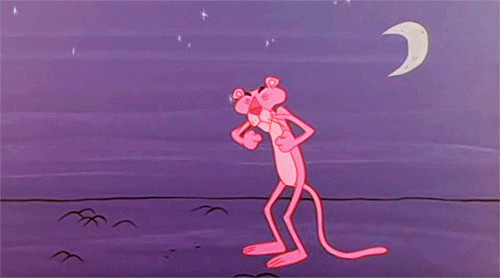
Blogging first became a thing when Justin Hall created what he called his "personal homepage" on Links.net, where he reviewed HTML examples from other online links (Zantal-Wiener 2020). 3 years later, Jon Barger, a fellow blogger, coins the term "weblog", reflecting the process of logging the web. Another 2 years later, Peter Merholz, a programmer, shortens the term "weblog" into "blog", to which Merriam-Webster would declare as the word of the year in 2004 (NDMU 2018).
~ TLDR ~
1994 - Justin Hall's "personal homepage" on Links.net
1997 - Jon Barger coins the term weblog
1999 - Peter Merholz shortens "weblog" -> "blog"
2004 - Merriam-Webster declares "blog" as their word of the year
The prime time of internet exploration (for the masses) between the late-90s and early-00s are also home to the births of iconic blogging platforms such as Blogger and WordPress (NDMU 2018).
These early days were the chance for the readers and writers of the world to digitalise their bibliophilic habits as they ventured new ways to connect with bookworms across the globe.
The Evolution:
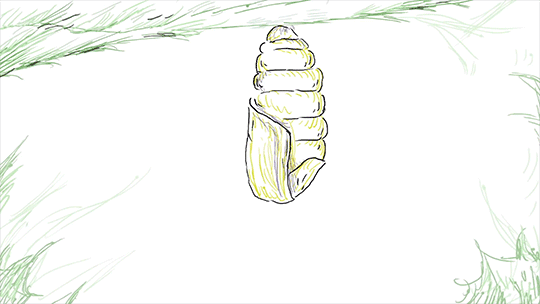
Right in the midst of blogging's mainstreaming years, the public launching of YouTube in 2005 sparked the evolution of blogging. With that, the wonders of blogging were no longer confined to the wordsmiths of the world.
YouTube's culture of video blogging, or vlogging, appealed to those who preferred audio and visual stimulation, thus continuing the reach of blogging as a whole (Maslanka 2017). This video blogging culture brought forth most of the blogging cultures still in tact today, such as the aforementioned Instagram Reels and TikTok videos, which are forms of blogging that invoke creativity in a different medium than what blogging first started as.
The Question:
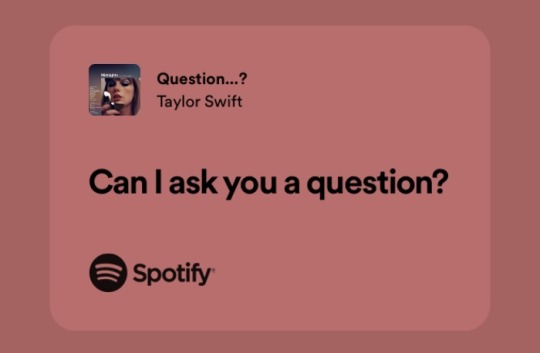
lyrics captured from Spotify
So blogging evolved from choosing the right writing style to choosing the right background music, but what does that mean? Does no one do the former anymore? Is everyone just trying to accomplish the latter?
Take, for instance, you feel like cooking something new. Some people would turn to a cooking channel on YouTube, while some prefer clicking on the recipe blogs that their search engine compiles for them. My friend would rather watch a video about the newest technology, whereas I would like to read about it in a blog post instead.
It all comes down to personal preference.
Numerous blog platforms are still around and are home to a growing number of blog accounts that cater to different genres of digital communities; because just as many people there are on this planet, exists a vast range of interests, preferences, and personalities. These aspects result in the creation of digital communities that almost anyone can find a seat in. These different groups then evolve within themselves to create their own set of cultures, norms, as well as trends.
So perhaps someone who spends their days watching Instagram Stories and TikTok Lives may seem to think that blogging is a dying flame, but to someone who replies to tweets and writes fantasy fiction on Tumblr, would disagree. In fact, posting short snippets of your day or sharing your thoughts in a tweet is a form of blogging in itself, specifically known as microblogging. Microblogging is an example of blogging cultures trickling down to make room for the readers and writers of the world who enjoy doing so, but in a more casual setting.
It is also important to note that personalities are not a black and white thing. Preferences are not an either or situation. There are many people who enjoy both reading blogs and watching videos.
・・・・・・
Besides leisure pursuits, blog accounts can also be used professionally. Setting up a portfolio blog could serve as a digital gallery of one's work (ThemesKingdom 2019). For example, a programmer's portfolio blog could include the programs they have coded or their experiences with different programming languages. The inclusion of a portfolio blog to a resume helps future employers grasp the personalities, morals, and ethics of the potential employee.
And along the lines of career-oriented blogs are money-making blogs; a solid option for the adventurers who seek a non-conventional career path. These type of blogs often rake in revenue through brand partnerships, affiliate links, premium content or private consultations (Polner & Bottorff 2023).
The Answer:
Definitely! I would confidently say that blogging is still relevant in the midst of Instagram and TikTok's uprising.
While there is no denying that Instagram and TikTok may be more popular amongst certain demographics, the future of blogging continues to march on, because as long as there are bookworms around, blogging will remain relevant ⋆。⋆☂˚。⋆。˚☽˚。⋆
︵‿︵‿ References ‿︵‿︵
Maslanka, M 2017, The Vlog Blog: History of Vlogging, MotionSource, 28 July, viewed 27 September 2023, <https://blog.hubspot.com/marketing/history-of-blogging>.
NDMU 2018, History of Blogging, Notre Dame of Maryland University, 22 March, viewed 27 September 2023, <https://online.ndm.edu/news/communication/history-of-blogging/>.
Polner, M & Bottorff, C 2023, How To Start A Blog And Make Money In 2023, Forbes, 31 July, viewed 29 September 2023, <https://www.forbes.com/advisor/business/start-a-blog/#:~:text=Blogging%20Is%20a%20Fast%20Way,can%20start%20earning%20any%20money.>.
ThemesKingdom 2019, 5 reasons why you should include a blog in your online portfolio, ThemesKingdom, 29 May, viewed 29 September 2023, <https://themeskingdom.com/blog/reasons-to-include-a-blog-in-online-portfolio/>.
Zantal-Wiener, A 2020, A Brief Timeline of the History of Blogging, HubSpot, 19 October, viewed 29 September 2023, <https://blog.hubspot.com/marketing/history-of-blogging>.
21 notes
·
View notes
Text
#OcculTea - A Reflection on Social Media and the Occult
A few days back, I came across a post by @ella.harrison, @the.redheaedwitch and @polish.folk.witch on Instagram which invites individuals within the occult community to participate in a dialogue around the topic of social media in relation to one’s occult practice. Several questions were raised as prompts, and I would like to — as a form of self-reflection, and to participate in the discussion — write a short post in response to some of these prompts.
Before I begin, a quick introduction for those who may be new to my blog and unfamiliar with me: I go by the name of Ivy Senna online. My practice is varied, and I share bits and pieces of my practice occasionally online, mostly to do with rituals I have done (witchcraft rites, adaptations of the Greek Magical Papyri, folk charms etc) or sharing photos of my astrolatry practice. I am a published author in the occult sphere, with my writings having been published by Hadean Press and Revelore Press and other places throughout the last two years. Still, my online presence is relatively small and I would not consider myself to be an ‘influencer’ or anything of that sort.
I am choosing to share it on my Tumblr rather than on my Wordpress blog (uponthealtar.com) due to the more informal nature of the discussion, and I will be focusing on my experiences with Instagram as that is my main social media platform nowadays.
What is my personal reasoning behind sharing my practice online?
I first began posting on Instagram in 2020. It started as a fun way to record my work, to make visual notes of my thoughts and discoveries. Then, it became a form of self-expression: ritual photography, in the right context, is something I find to be genuinely fun and beautiful. In time, Instagram became a way to promote my Wordpress blog. After I became officially published at various different places, social media became a way to promote those pieces of writing as well. Now, it is an amalgamation of a promotional tool, a place for me to post ‘cool’ photos in an artistic manner, to share bits and pieces of myself and my practice, and to keep in touch with friends and interact with my readers alike.
What am I looking to achieve by participating? Do I seek to educate, learn or connect?
I believe there are two reasons why I, as a writer, began writing. First, is because writing keeps me sane: it is my source of escapism, of the nutrition of the heart and soul, writing being the thing that replenishes me and shelters me both. Second, is because I have something to say. Sometimes I may have some thoughts on a particular god or star or piece of folklore, thoughts that I want to share, to know that I am not alone in my experiences. Sometimes it is the love for my gods and spirits that makes me want to share something about them to the wider world who may not know certain sides of them. Sometimes it is the irritation at seeing misinformation that makes me want to spread accurate information as a form of pushback. Sometimes it is the rage at realizing that — within this English-speaking social space — the discussions regarding my local folklore and practices has been dominated by voices from outside the local culture, voices of those who are arguably misrepresenting or fetishizing the things I hold dear.
So yes, I create content as a way to both connect and educate.
Consuming social media content, on the other hand, is partially how I learn. I say partially because although there have been great tips and tricks that I have gathered via Instagram posts and reels, I find that most of my knowledge and skill comes instead from experimentation, from hard-earned experiences, from autodidactic learning via courses and grimoires, much of these being guided by my spirits. In this case, it can be said that I do use social media to connect myself with those whom I can learn from. Yet, time and time again genuine friendship has arised from these social media encounters. Many of these bonds of companionship and care have come to mean a lot to me.
How do I think social platforms such as TikTok, Instagram and YouTube have each impacted education/sharing information?
I do not use TikTok nor do I engage with occult YouTube (much of my YouTube followings are simply food channels or video game channels), I will refrain from commenting on those platforms. But, one thing I notice about Instagram, is how things such as ‘reels’ tend to be prioritized by the algorithm over photos and mundane posts. And, as reels can only be a few minutes long at most, I believe that there is a danger that it may lead to an oversimplification of complex magical concepts. There may be a risk of people preferring things that are fast, easily digestible, and visually engaging to look at— when many times witchcraft is anything but palatable. This perhaps is why I very much prefer blogs, or podcasts, or anything long-form where nuances can be explored.
However, this is not a criticism though of those who post reels in order to advertise their occult businesses. People have to make ends meet, to put food on the table. What I am criticizing instead is the very structure of capitalism and consumerism that is promoted by platforms such as Instagram.
Out of what I share on social media, how much of it is staged vs reality?
All the photos I post of the devotional rites I perform are real. I am not one to simply just stage something without actually going through with the offerings or the prayers. However, there is a degree of things being ‘staged’ in the sense that sometimes I do move things around to make sure the lighting looks good, or I edit things in post-production to make the colors more aesthetically pleasing. More than that, when it comes to ritual, certain things are intentionally hidden out of frame. For example, I may show the front of an object but hide its back because it is there that I have inscribed specific names or petitions behind it. It must be known too that not all of the rites I do look as pretty as the things I post. Hence, it is less of a question of how much of what I share is real, but more of a question of how much of what I do goes unshared.
Do I think there is an element of censorship in online spaces? How do I decipher what is ‘appropriate’ to share online versus what to keep privately?
Of course there is censorship among online occult spaces— the very word ‘occult’ or ‘occulted’ means to be hidden. To think otherwise is foolishness, and if someone claims they are sharing everything they practice online then I wonder how much of their practice is actually genuine.
If I choose to not share something, there are usually two reasons: practicality and privacy.
In terms of practicality, it’s just the basic truth of how I am not in the habit of snapping photos if I am outside doing rituals at 3am alone in an abandoned area of my city. It’s dangerous enough being alone in such a situation; there is no way I’m going to wave my iPhone around to lure in muggers and thieves. Likewise, much of my ritual requires me to be in a trance-state. Even if something amazing happens during the ritual, I am not about to break the state of flow I am in just to take an aesthetic photo for social media.
In terms of privacy, some things are just too personal to share. For example, I do not share photos of the weekly offering rituals I do for my spirit court. No one, aside from my closest friends, have even seen my ancestral altar or the full extent of my current working altar either. Even then, there are times when I would blur out things or crop out things before sending photos to those whom I trust— not because I don’t trust them, but because I respect the privacy of my spirit. Witchcraft is inseparable from spirit work, and my spirits deserve their privacy because some things are meant for their eyes and mine only. There are things I don’t write about nor post about. Secrecy is a part of witchcraft, and there are cases where power shared is power lost. A witch, in my opinion, should know how to keep their sharpest blade hidden and their trump card close to their chest.
Additionally, many rituals are just too much to be shared, for a lack of a better word. There are times when I am naked, crawling on all fours, smearing my menstrual blood onto ritual objects. There are times when I work myself up into a frenzy, where I am crying and shouting, ritualistically making use of the tears running down my face and the emotional turmoil within my heart. In other words, there are moments which are just too intimate and vulnerable to be shared.
Other reasons are more selfish: there are things I fear being misconstrued if I do share them. I do not want the things I hold dear to be misappropriated by people who don’t understand what they are doing.
How does one maintain the balance of authenticity and content creation?
By touching grass.
I jest, but sometimes you really do have to log off and be with yourself.
It’s easy to lose yourself in the online world, especially if a lot of your friends are online too. But, spending time with your spirits — in the dirt, under the stars, among the waters — is a good way to remind yourself of what your practice actually consists of and why you are doing all of this. Content creation is an extra thing, not the core of what you do. Another rule I have is that I don’t post something unless there is truth in it. I will never claim to do a ritual I did not actually do. If something is UPG or inspired by the works of others, then I cite and declare that. I will never claim that something is mine when it is not mine.
It is true though that there is a degree of performativity on social media: we only show our best selves here, rarely our vulnerabilities. For me, it is important for me to remind myself that all the people I look up to — on social media and in real life — eat and shit and have sick days and days when they just feel like doing nothing too. They edit themselves online and so do I. We all do, to a degree. After all, no one needs to know the nights when we stay up late questioning our sanity or having a mental breakdown over feelings of shame or inadequacy.
Everyone lies, yet to remain authentic is to be true to our heart, to acknowledge that we are both the mask and the performer wearing the mask.
How can we help each other in removing the external peer pressure and grow in community?
Everyone does something stupid every once in a while. We all fuck up from time to time— so why not share that?
I understand though that it is harder said than done, for consequences of occult mishaps can be emotionally painful and sometimes severe enough to derail one’s life. Yet, all of this reminds me of recent discussions in academia, of how the pressure to produce results of experimental success has contributed to how people may feel like they have no choice but to exaggerate results or, in the worst case scenario, falsify their findings. It is similar in the occult scene: we praise those who have seemingly amazing successes in their magic, not seeing the time and effort that went into perfecting their crafts, the countless occasions where they have failed before they succeed.
I think we should be open to discussing when spirit pacts don’t work out, when a relationship with a god isn’t what you thought it would be, when a magic ritual ended up having unintended consequences et cetera. I think we should be more open about the pain and heartache that comes with witchcraft, how terrifying and lonely and maddening it can feel sometimes, how sometimes you may feel lost in a fallow period where you feel out of touch with your gods and spirits.
All of this to say, I think we should normalize failure and being less than perfect.
15 notes
·
View notes
Text
A More Personal Sort of Ramble
Hi. Let's talk about 2023.
It has, actually, been a while since I sat down and did one of these types of posts, so forgive me if I'm a little rusty. Or, if we're being honest with ourselves, Twitter threads, since it's actually been so long that it dates back to the time my main online presence outside of the WordPress blog was actually on that godforsaken cesspit of a website.
(Now, of course, we have upgraded to *this* godforsaken cesspit of a website.)
So this year has been... a lot. For once in my life, however, I don't actually mean "a lot" in a negative sense. On the contrary, this year has, to put it bluntly, probably seen me at the happiest I have been since my depression really started to kick in in earnest back in 2015.
There are the obvious indicators we can point to, namely the fucking insane traction that the blog has gained. A little under 2400 views in a year may be peanuts to some, but when you consider that that's very nearly equal to the amount of views my site gained across the entirety of 2017 to 2022, it's a level of growth that I couldn't be happier with.
And part of that growth has been the migration to Tumblr, which went far better than I could have ever hoped for. In all honesty I probably should have come here sooner, given the generally more blogging-supportive ecosphere that exists, but it's better late than never I suppose.
More importantly, though, I wrote a lot, and was actually very happy with much of what I wrote. 2023 has been the first year where I can honestly say that I didn't immediately feel disdain for a post upon hitting Publish, and I can't overstate how huge that feels.
And really, that's what this year has been about. I am not in the habit of airing every part of my personal life these days in the way I did back in 2020 or 2021, for the simple reason that my audience has expanded well beyond the few devoted online acquaintances I had back in those days. Suffice it to say, however, that I am doing very well, and I am happy in my own skin for the first time in a very long while. I have dreams for the future that can actually qualify as, well, dreams, as opposed to general dread-filled nightmares and apocalyptic visions that'd make Frank Black blush.
And through it all, there's been my audience, who I genuinely consider to be one of the best small corners of the Internet. I'd like to take credit for the vibes not being abysmal, but the truth is... the bulk of that credit belongs with you folks, not me. So thank you, genuinely.
As with most of these longposts, there's the self-serving Ko-fi plug to get through; it can be found here, as always. Even if my hope of actually making some money from these scribblings of mine remains a far-flung dream, however, rest assured that I'm not going to stop any time soon. We might have finished the bulk of the Virgin stuff, but we're only just beginning to wade into the BBC Books years, and I hope you'll stick around with me to see what the future holds for Dale's Ramblings in 2024 and beyond.
Thank you all for being simply incredible. You're all damn fine people, and I'm forever glad to have your readership.
4 notes
·
View notes
Note
Hi VK - long time no chat!! I hope you're doing well lovely :) I have a question for you and a favour as well (if that's alright). My question is: have you or are you working on compiling Casaslindas (Helen Torres/Twinkie) files from her Wordpress and Tumblr accounts? There was two requests for her files from about 2 years ago on Packrat and you said you were in the process of downloading her files and finding the meshes, but you didn't have the time then to do this, but maybe in the future.
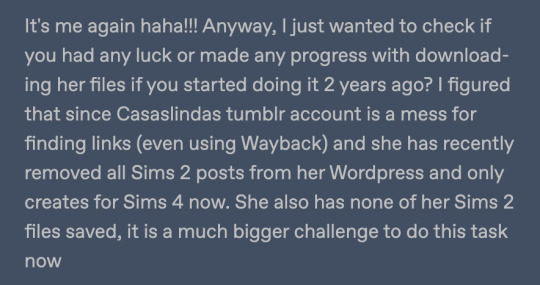
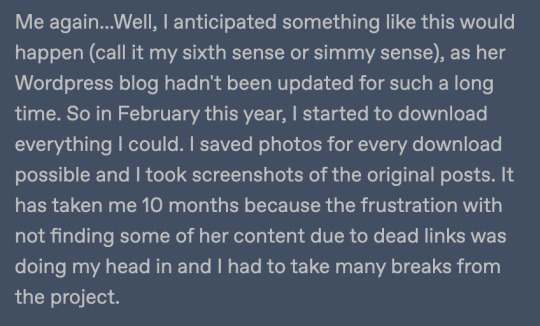
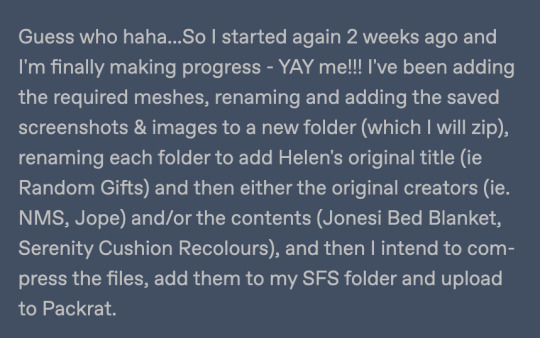
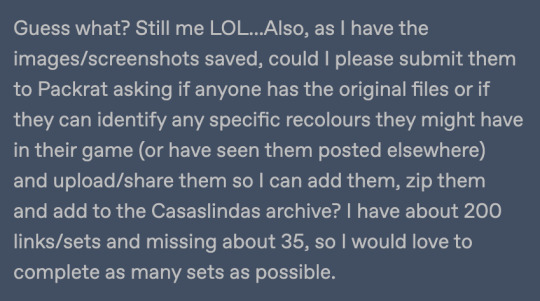
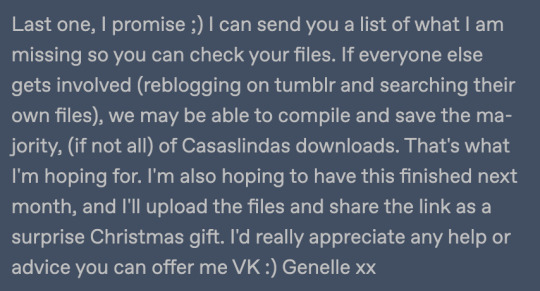

Hello Genelle! :-D always nice to hear from you!!! Hope you're doing well too! I'm doing fine, with the exception of school taking up much of my time (hence me being inactive on tumblr and very inactive on packrat). I also don't have my pc with me where I live now, only my mac, which I don't have anything ts2-related on sadly.
I started archiving Casaslindas' stuff back when the mediafire purge was about to hit (dec 2020?!?!?!? how time flies wtf) and I have archived and found most (if not all perhaps?) of the necessary meshes of Casaslindas downloads until page 17 (or 23?) I think, with the exception of the posts with already dead links. I have a post in packrat's drafts with links to the missing downloads - until page 17 (or 23, or however far I got). I don't think I touched her tumblr though, but I'm not quite sure.
That's awesome though!! To hear you started archiving her stuff. I totally get your frustration, both with her blog (my god her wordpress was a pain in the arse to navigate) and the missing/dead mesh-links. I, too, had to take many breaks hahaha. Much cred to you though for taking the stick and running with it!!!
I didn't know she deleted her ts2-posts.... that's bad news. Your sixth-sense is amazing haha! I'm going home - to where my pc is - in December, so I can re-upload the things I have archived from her (and the meshes I found) then.
And of course you can submit the missing downloads to packrat! Hopefully someone can re-upload. With pleasure, it might take me a while before posting (as you all might have already realized) but I do it eventually :-D and you're more than welcome to send me your list as well, unfortunately I won't be able to check my files until December :-( perhaps earlier, if I go home over a weekend sometime before. If so, I'll let you know!
I hope I didn't miss replying to anything, if I did, do send me another ask! My inbox is always open<3 thank you so much Genelle for your hard work and dedication!! It was lovely to hear from you!
6 notes
·
View notes
Text
How AI and Web Development Are Shaping the Future
This exponential growth is redefined by artificial intelligence web design are impacted too, AI have ability to analyze data and automate processes, with complicated web development frameworks producing seamless user experiences. AI and web development together work to create a faster, smarter, and intuitive digital future—from personalized content delivery to proactive cybersecurity. Also , check our recent blog about the new sensation Deepseek AI and beginner level basic programs for java.
Artificial Intelligence Knowledge and Technical Skills in Web Development
Combined with knowledge of AI, web development calls for specialized skills in ML, NLP, and data analytics—a combination that now allows developers to use tools such as TensorFlow, PyTorch, and OpenAI’s GPT-4 to develop intelligent systems.
For example, AI-driven chatbots answer 68% of user queries without humans ever intervening , resulting in 90% drops in response times. AI plugins in modern-day content management systems like WordPress and Drupal automate SEO optimization and even drive a 50% increase in search rankings (Search Engine Journal, 2023).
AI also simplifies working on the backend. In fact, Netflix relies on its machine-learning recommendation engine that generates up to 1 billion dollars a year in savings via reduced customer churn (Medium, 2020).
AI testing tools like Testim.io and Selenium find bugs 40% faster than manual efforts—a fact that proves the value of bottom-up and well-thought-through web applications (Forrester, 2022). These also demonstrate the technical prowess needed to couple and web development, thus going beyond conventionalism of Website builder AI.
to know more check here
0 notes
Text
Writing horror in VR with phasmophobia
Introduction
VR or virtual reality, is, at its very core, "a technology that can create a complete environment or world for the user to experience" (Cisneros et al., 2019). This basically means that it's a medium for the storyteller to recreate an entire world in a separate virtual dimension. This virtual dimension can then be accessed by users using a virtual headset and depending on the extent of immersion, the storyteller wants a user to feel, they can also be hooked to other immersive mediums like haptic suit, temperature control, etc.

Fig; My iClinic, 2023. The future of VR headsets in eye clinics. [image] Available at: https://myiclinicn.sg-host.com/wp-content/uploads/2023/10/the-future-vr-headsets-eye-clinics-1024x573.jpg [Accessed 6 January 2025].
Virtual reality is a very different kind of storytelling medium because, unlike other mediums, VR doesn't make your consciousness interpret the medium; instead, it makes our consciousness the medium. (Smith, 2024). This makes it the perfect channel to host a genre like horror, as fear is something way more than the cheap jumpscares and SFX we see in today's day and age. Fear is about buildup; it's one of the most primitive human emotions. And no other game takes more advantage of this than "Phasmophobia."
Phasmophobia is an indie horror game developed by a small British studio called Knetic Games. It was released on early access in September 2020, and it quickly rose to popularity thanks to its immersiveness, resulting in it winning the title of best debut game in 2020 at the "game awards.".
This blog will analyze how "phasmophobia" achieved this level of success and how VR was used as an extension of human consciousness to achieve this feat.
Overview
In Phasmophibia, immersion is the key selling point as the player takes on the role of a paranormal investigator/s who are tasked with exploring several different haunted places and identifying the types of ghosts that haunt that particular place. These haunted locations work as a perfect setup for virtual immersion, as the developers use the eerie atmosphere to their advantage by adding several physical interactions like footsteps, creaking of doors, using flashlights, etc., which are actions that require physical participation, and this physical participation makes the player directly responsible for the consequences of their actions, making it more creepy and real.

Fig: Gamerant, 2024. Phasmophobia logo over ghost. [image] Available at: https://static0.gamerantimages.com/wordpress/wp-content/uploads/wm/2024/10/phasmophobia-logo-over-ghost.jpg [Accessed 6 January 2025].
This aligns with the research done by Zhang H and their colleagues in a paper named "Decoding Fear: Exploring User Experiences in Virtual Reality, Horror Games" where they found that the virtual reality media of horror games automatically added a layer of fear response amongst the participants even before they started playing the game, especially at night or when alone. (Zhang et al., 2024).
Mechanics of Manipulating Players
As we already know, horror in VR is heavily relied on the interplay of feelings of being in control and helplessness. Phasmophobia has mastered this approach by making players responsible for each one of their actions, giving them choices, and inciting a sense of authority within them while also confronting them with unpredictable and uncontrollable events, which often and not are the direct results of the actions a player deliberately and independently takes.
Some of the key techniques phasmophobia uses to master this approach are:
Audio Design: The sound-space of this game has been meticulously perfected with things like proximity chat, footsteps, muffled whispers, electronic distortions, etc., creating a sense of omnipresent dread and making players feel like they are never alone. Even the silence within the game is quite loud, as it is littered with a plethora of other background sounds like breathing, doors creaking, etc. This makes the player question every sound they encounter, making them ask "Was that me or my friend, or did this sound come from somewhere else?"
Environment Design: Phasmobhobia uses claustrophobic settings to incite a sense of preexisting fears the players have. It uses locations like abandoned cabins and narrow hallways to further distance the player from any sense of safety and make them feel more alone and trapped. The limited field of view in VR headsets amplifies these effects, forcing players to confront their fears head-on.
Dynamic AI: The game's ghosts are governed by an AI that reacts to the player's behaviors, including spoken words; these reactions are according to the behaviors mentioned in the ghost book, which is a guide that players use to find the type of ghost within a mission. But this, at the same time, makes players directly responsible for any hauntings or deaths that happen. As for example, Shade is a type of ghost in phasmophobia who only responds to people when they are alone, so now it's on the player to decide to go alone in the haunted place to get answers from the ghost. They can totally skip it and use other clues to get to their objective, but this choice is ultimately given to the player.
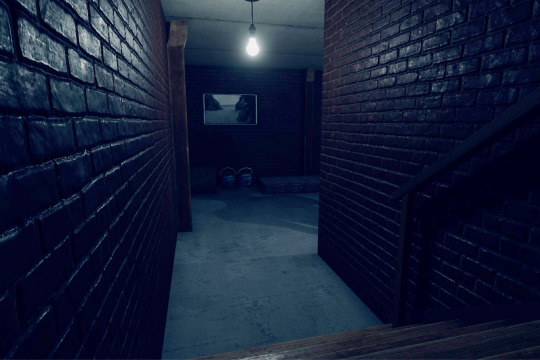
Fig; The claustrophobic environment setting in Phasmophobia. The Washington Post, n.d. [Title or description of the image, e.g., Protestors in action, or relevant detail if available]. [image] Available at: https://arc-anglerfish-washpost-prod-washpost.s3.amazonaws.com/public/P7PMXMO4QBFJZI7EHEP34LZOEM.jpg [Accessed 6 January 2025].
Drawbacks of using VR in horror setup
While VR can surely increase players' sensation in playing horror games, making it feel more real, interesting, tense, and even scary (Armanto, Anthony, and Pickerling, 2021). It is also true that using Virtual Reality comes with its own set of drawbacks, most notably of which is the motion sickness and dizziness caused by wearing headsets for a long period of time (Armanto, Anthony, and Pickerling, 2021). And this is particularly important for horror games because of the heavy reliance on lights and character motion as a part of storytelling.
Conclusion
Phasmophobia highlights the unique capabilities of VR to redefine the horror genre. By using immersion, interactivity, and social dynamics as a tool to empower its story, the game creates a deeply engaging experience that challenges traditional notions of fear and entertainment. As VR continues to blur the lines between reality and fiction, the study of its psychological and cultural implications will remain a vital area of inquiry, plus we need more studies into the effects of individual elements of phasmophobia and how it affects its user in both a virtual reality setting and a normal Desktop setting. Plus there is a dire need to have increase the research being done on the motion sickness affects of a virtual reality setup, as we need to segregate and eliminate all factors contributing to the said adverse effects. For now, Phasmophobia works as an excellent case study and a testament to the potentials of VR in one of the most challenging genres in modern media.
References
Armanto, H., Anthony, G. and Pickerling, C., 2021. Implementation and Impact of Virtual Reality on Survival Horror Games. [Publisher/Journal if known]. Available at: https://www.researchgate.net/publication/353614055_Implementation_and_Impact_of_Virtual_Reality_on_Survival_Horror_Games [Accessed 16 Dec. 2024].
Cisneros, A., Maravilla, M., Murray, B., Scretching, D., Stoddard, A. and Redmiles, E.M., 2019. Defining Virtual Reality: Insights from Research and Practice. [Publisher/Journal if known]. Available at: https://www.researchgate.net/publication/332201962_Defining_virtual_reality_Insights_from_research_and_practice [Accessed 16 Dec. 2024].
Smith, M., 2024. VR Storytelling. In: Proceedings of the International Moving Image Cultures Conference (IMOVICCON 2023, pp.137). Available at: https://www.researchgate.net/publication/379636493_VR_Storytelling [Accessed 16 Dec. 2024].
Zhang, H., Li, X., Qiu, C. and Fu, X., 2024. Decoding Fear: Exploring User Experiences in Virtual Reality Horror Games. Proceedings of the ACM SIGCHI Conference on Human Factors in Computing Systems, pp.1-12. Available at: https://dl-acm-org.ezproxy.herts.ac.uk/doi/pdf/10.1145/3629606.3629646 [Accessed 16 Dec. 2024].
0 notes
Text
New Blog Post
Here's a post about my new blog on my new blog. I'm Raven and this will be a review blog by me. I’m an unpublished writer with a short attention span and compulsive overthinking, so this blog will be about whatever is in front of me at the time, which will mostly be anime and movies.
Writing is hard, so the rest of this new blog post will be in the form of a Q&A.
Preferred Blogger Name: Raven
Gender: Bird
Sexuality: Bird
Species: North American Common Raven (Corvus Corax Principalis) (a type of bird)
Nationality: American/bird
Why are you a bird?: Why aren’t you a bird?
Age: Thirty-something millennial (very old for a bird)
Why would a bird write a review blog?: I’m an opinionated bird.
Why would you start a new blog on tumblr in the year 2024?: Because there's not really a better place for long self-published text posts. Wordpress isn't a real website and custom domain names are for bored boomers. Most review journalists who have actual readerships work for large publications. If you represent one of those please feel free to send me serious job offers. As a bird I am willing to accept payment in the form of large amounts of American dollars.
How does your scoring system work?: My scores are systematic but not scientific. Most things I review will be compared against other media from their genre. I don’t see any point in trying to compare a fantasy like Dungeon Meshi against shonen garbage [complimentary] like Jujutsu Kaisen or against romantic comedy like Kaguya-sama: Love is War. They exist for different needs. I’d much rather grade Kaguya against Komi-san*. An A+ means I consider something exemplary for its type, anything lower than that means I see significant flaws, and an S transcends genre to stand in a category of its own. I won’t usually bother with things that don’t interest me enough to either love or hate them, so don’t expect to see many Cs. You may see some Fs now and then.
Favorite anime?: Violet Evergarden
Favorite manga?: Sousou no Frieren
Movie?: Back to the Future III**
Book?: Coyote Blue
Game?: The Legend of Zelda: Ocarina of Time
Subs or Dubs?: We do not respect the dubbing industry on this blog.
What the heck is isekai?: Isekai is a genre in fiction in which an ordinary person is miraculously transported to a fantastical new world, sometimes after literally dying and being reincarnated there. The name is taken from the Japanese for world, “sekai,” and means literally “another world.” This genre blew up in Japan in the early 2010s and now it’s nauseatingly pervasive in anime, especially of the mass produced and low budget kind. If you’re asking this question it means you’re probably older than I am and haven’t seen a lot of anime (and I am in my thirties, so I'm about to expire any second now), but western media does this too and it’s by no means a new genre. The Chronicles of Narnia, Alice in Wonderland, and The Wizard of Oz*** are all classic examples of proto-isekai. Proto-isekai was also popular in the 80s and 90s with various hits and mistakes such as The Flight of Dragons, The NeverEnding Story, and Super Mario Bros. (1993). Isekai is also a popular device for zero-effort Hollywood cash grab adaptations of video games or other animated or foreign media, such as 2020’s two-hour-long U.S. Military commercial Monster Hunter, the upcoming A Minecraft Movie, or The Super Mario Bros. Movie (2023). If your protagonist is an obnoxious British or American adolescent, or otherwise jarringly out of place in a fictional setting, it’s probably isekai—but not always. The Last Starfighter, Harry Potter****, and most time travel stories are NOT isekai. Transport by isekai is usually miraculous, individualized, and uncommon. The Last Starfighter doesn't count because the obnoxious teenage protagonist is simply recruited by aliens who are not doing anything that’s miraculous to them—in fact he’s one of many candidates for the job (of being the last starfighter) and even initially refuses to go. The TERF wizard school books aren't isekai because they take place in the real world and it seems miraculous to their protagonist only because knowledge of magic is carefully suppressed by a fascist-conservative wizarding government. Most time travel stories aren't isekai because time travel is usually done through technology that can be planned for and used repeatedly by anybody with access to it, but some time travel does count as isekai: Star Trek IV: The Voyage Home is NOT isekai because it's fully explainable (in setting) and involves a planned and repeatable solar slingshot maneuver, but A Kid in King Arthur's Court does count as isekai because the protagonist finds himself in fantastical medieval times after falling through a mystical chasm opened up by an earthquake. These stories all look marginally similar, if you ignore all other genre conventions, because they make use of the extremely common narrative concept of "fish out of water," but trying to argue that any fiction that involves an unprepared protagonist traveling to somewhere unfamiliar is an isekai is like saying that all squares are triangles because you can fit triangles inside of them, and it makes you sound silly.
Why do you hate isekai?: Because I love fantasy. I love make-believe worlds and intricate fictional histories. I also value escapism, and nothing shatters immersion like some whining twerp of a protagonist constantly interjecting to remind you about the real world. Isekai is blunt and dumb and even condescending in what it expects of its audience. It offers escapism in the laziest, most point-missingly literal way and I hate everything about it. You can still get some of the same things out of isekai as you would from an actual fantasy story, maybe, kind of, if it’s one of the really good ones, but it’s different even then. More often, isekai is cheap, half-hearted and half-baked “fantasy” too embarrassed to commit to a sincere narrative or a truly immersive world. It’s stale, commercial, oversaturated trend-chasing, it’s lazy, and it’s a crutch for writers too weak to invent something original or genuinely heartfelt.
There are a few (very few) isekai stories I like, and some even have reviews already written for this blog, but you won’t see many others here unless I’m angry about them. (Which I often am.) Heck to isekai.
*Kaguya scores better but I like Komi more. Both are excellent. Komi S3 when??
**Back to the Future is not an isekai. The DeLorean is technology that anybody could use, that’s kind of an important plot point.
***Alice in Wonderland and The Wizard of Oz are arguable since they both have All Just A Dream endings, but I consider All Just A Dream more of a (usually bad) narrative technique rather than its own genre. However, "All Just A Dream" endings undercut stories in a way very similar to isekai beginnings, so it would be very funny to deny two early isekai classics because of that.
****by Hatsune Miku
1 note
·
View note
Text
Ta-Da! List: Saturday, June 8th

The image was made in Canva; check it out at the [referral] link here!
I share my “Ta-Da! List” every day so everyone gets a daily update and I have a reminder of what I’ve accomplished.
To learn more about “Ta-Da! Lists”, and other ADHD life hacks, check out @adhdjesse’s book Extra Focus: The Quick Start Guide to Adult ADHD.
Abbreviations
- MT: MonriaTitans - O&T: Opinions & Truth Blog - WGS: The Weekend Game Show - ASO: Artist Shout-Out - IG: Instagram - BMAC: Buy Me a Coffee - TDL: Ta-Da! List
Ta-Da! List
✧ throughout the day: - kept emails manageable - loaded the dishwasher - filled out today’s TDL
~~~~~~~~~~~~~~~~~~~~~~~~~~~~~~~~~~~~~~ ✧ on the mobile phone: - YouTube: watched Upper Echelon’s short “Video Games Play YOU… (Not The Other Way Around)” - Hive: shared today’s ASO and the “LDSS Big Changes” announcement
~~~~~~~~~~~~~~~~~~~~~~~~~~~~~~~~~~~~~~ ✧ on the bedroom setup: - YouTube: watched and/or listened to Jim Sterling’s videos “The Problems With The Epic Store”, “Quantic Dream Or Quantic Nightmare?”, “The Business Of Lies”, and “The Exploitative Push For Social Networking In Games” - Movies: watched “The Nightmare Before Christmas” - O&T: shared today’s TDL to various social media
~~~~~~~~~~~~~~~~~~~~~~~~~~~~~~~~~~~~~~ ✧ on the office setup: - WGS: gave a human artist, Adam Miller, a shout-out by sharing it on O&T, Tumblr, and other social media; shared a “Big Changes” announcement regarding ASO sharing, and what’s going on tomorrow, to The Titans’ Discord, IG, and other social media; changed the IG links in the Google Doc ASO list to their Tumblr or O&T links; prepared the ASO for tomorrow, June 9th; updated the StreamElement “SocialMedia Rotation” with the MT IG username; set up the Overlays in Streamlabs for “Super Lesbian Animal RPG” - Gaming: played “Final Fantasy XIV” - YouTube: watched and/or listened to Jim Sterling’s videos “The Addictive Cost Of Predatory Videogame Monetization”, “Stadia, Subscriptions, And The Death Of Game Ownership”, “G2A Isn’t Just Worse Than Piracy… It’s Also Very Stupid And Embarrassing”, “The ESA Is A Big Piece Of Shit”, “EA Doesn’t Like Being Seen As The Bad Guy? Too bad!”, “The Annual Square Enix Letter From Hell”, “The Game Industry Hides How Bad The Really Bad Layoffs Are”, “The Game Reviewer Who Hates Games”, “Single-Player Healthcare”, “The Most Influential Game Of The Decade”, “Liar’s Year 2020”, “When Inane Creeps Attack Actors For Something A Fictional Character Did”, “A Truly Fucked Up Industry”, “Digital Homicide Resurfaces With Some Incredible BS”, “Violence In Videogames, Wankers In The White House”, “Anger”, “Blood, Guts, And Videogames”, “Muscles Of The Apocalypse”, “False Advertising Vs. Narrative Subversion”, and “Should ‘Metroidvania’ Be Abolished?”
~~~~~~~~~~~~~~~~~~~~~~~~~~~~~~~~~~~~~~ ✧ chores and miscellaneous: - Food: had coffee and chocolate for breakfast; went to family dinner; had more chocolate - Chores: checked the mail
—
Well, these are all the updates I had for today! Thank you for reading!
May every decision you make be *in the spirit of fairness* and may the rest of your day *NOT go to $#!7*!
~~~~~~~~~~~~~~~~~~~~~~~~~~~~~~~~~~~~~~~~~~~~~~~~
Enjoy what I do? Please consider supporting via Buy Me a Coffee (BMAC)! Like what you see and want to know when there’s more? Click here to subscribe for updates and/or hit the Follow button! This post contains affiliate links.
Watch MonriaTitans on Twitch, YouTube, and Rumble! For more about MonriaTitans, click here!
View On WordPress
#Achievement#ADHDJesse#AffiliateLink#Announcement#Announcements#BecomEmpowered#BecomeSmarterEveryday#BEmpowering#Blogger#Blogging#Book#Bookshoporg#Canva#DailyAchievements#DailyUpdate#DesignedWithCanva#ExtraFocus#LearnSomethingNewEveryday#MonriaTitans#MT#NDBlogger#News#OaT#ReferralLink#ShaheenKhan#TaDaList#TaDaLists#TMA#WGS
0 notes
Note
Hello, @pointedterrors! I may not be Neil Gaiman or a well-established author at all, but I happen to have majored in literature and gone on to work in journalism and publishing, so I thought I might share some of my experiences. Please do keep in mind that I am not from an English-speaking country at all, but I figured some general aspects could still be of interest. I'll touch on some of your points in the order that makes sense to me.
First: a major in journalism was also not an option for me. However, while working in journalism, just about none of my peers had majored in it either, and I worked for the biggest printed publication in the country.
If I had to estimate, the largest portion had degrees in communications, then some sort of humanities (whereas the general liberal arts or the specific literature, philosophy), then political sciences and social studies. These were the people who had some leeway to move between sections of interest. Some particularly specific degrees--fashion, cinema, visual arts, law, economics--would've been allocated to very specific sections.
Courses in media studies are a great start. Where I worked, there was an annual workshop that they made their interns take, and that was free for anybody else who could pass the strict vetting. Seeking workshops or internships will probably teach you a lot, even if you can't formally study journalism.
Second: unless you're already fairly involved in publishing or have specific authors whose releases you look forward to, it's hard to keep track of new books unless they have already generated some buzz. Books published in 2023 will have had fewer than nine months to do so! It's quite the tall demand for them.
Books are by no means dying. The industry had seen its record year in 2018, then a decrease in revenue in 2019 and, naturally, 2020. However, it has since recovered, and 2023 is already ahead of aforementioned record year. Keeping up with the Publishers Association is a good way to know about what's going on in the anglophone side of the industry.
Third: the notion that we've passed the point where we can create new scenarios is--rather amusingly--very, very old.
The wonderful Argentine writer Jorge Luis Borges opened the 1947 short story "The Immortal" with this real quote:
Salomon saith, There is no new thing upon the earth. So that as Plato had an imagination, That all knowledge was but remembrance; so Salomon giveth his sentence, That all novelty is but oblivion.
We've got the fairly popular The Hero with a Thousand Faces is possibly how we got Star Wars. The Thirty-Six Dramatic Situations in 1895. The Basic Patterns of Plot in 1959. The Seven Basic Plots, which the author began working on around 1970, but that did not get published until 2004, which is also fairly popular. 20 Master Plots from 1993. And yet, we’ve kept creating.
All of the above are worth a read to learn something about the history of literature. Mostly, they teach us that humans will always be humans. Isn't that just wonderful? My own belief is that new knowledge born into our world will eventually find its way into our ever-familiar structures, and the stories born out of this union will always find a place in our ever-changing world.
Fourth: how do you find newer books to read? BookTok in particular is keen on new releases, and a good place to look if you want to find out what to look forward to. Be careful about how you guide the algorithm (watch videos you care for in full, like them and at least copy the share link, comment if it was particularly useful--avoid doing this for content you do not care for, and make sure to also hit "not interested" when that's the case), and soon enough you'll have recommendations that are more tailored to your interests.
Find the pages for your favorite authors, whether that's a Wikipedia page, a Facebook profile, a WordPress blog, or a profile written on some cultural association's page. See if they ever won or were nominees for any literary awards. Find the shortlist for the running edition. There you have it--a vetted list of the best that will also be fairly recent. This is also a great way to learn about any particular genre or local literary trend.
If there are book fairs around you, try to find their program and see if there are book presentations beyond what's advertised on posters and social media posts. Go to any that interest you. The smaller ones, in particular, are where authors will be able to interact the most with their audience, and where you might meet the people publishing locally who will be very attuned to what goes on in that world at that moment. Yes, you hate to hear it: this is networking, which brings me to my following point.
College is a great time to find reading and writing circles. Find these people. Let yourself be encouraged to participate in the contests that your college, your library, or your state hosts. You'll get invaluable experience by reading, workshopping, and analyzing the trends you can see in the results of these contests. Sometimes, you might even get published for it, whether that's in a compilation of winners that will only ever get a single run or a magazine that will be dead three years down the line or an independent publisher that has a cult following. All of these experiences matter. In my experience, the people who stuck for the points I've made in this and the previous paragraph are the ones who've kept getting published along the line.
Hi Neil,
I am a college-aged person who has been into writing and other creative based careers/hobbies since I was a child. For a while it was theatre, then journalism, and now I am interested in writing my own fiction stories.
Of course, I still have passion for all of my former endeavors, but a key reason my focus has shifted aside from aging is fear for the future. “Everyone wants to preform, unless you are one in a million you will never get the chance.” or “Journalism is a dying career.” Applying for schools, so few colleges even offered journalism as a major option, which surprised me.
Now that I am looking into writing fiction, I am once again in that same boat. My media studies professor was discussing literature, and he asked the class a very thought provoking question:
“Have any of you guys read a book that came out in the year 2023?”
Nobody raised their hands. Thinking back on books I’ve read within the past few years, I can only remember reading one that came out while I was in high school. Everything else had been older than that.
It made me take a major pause. Are books dying? Have we surpassed the age where it’s possible to create entirely new worlds and scenarios and have other people read them? How do we keep reading alive?
Of course, one man alone cannot hold all the answers, but I’m curious- What is your opinion on this as a well established author?
Thank you for your time!
I think the majority of the books published in 2023 are still in hardcover and that college age students will mostly be waiting for the paperbacks to come out. And that the vast majority of books were published before 2023.
1K notes
·
View notes
Text
Romance is More Than Genre but We Aren't Treating It That Way
I'm back! I stopped blogging to concentrate on Vindico, but now that the first draft is done, it's time to start setting the stage.
I finished the first draft of Vindico in the final hours of 2023. It’s a work that began just as short character sketches starting in 2017 and finally taking shape in late 2020. What I didn’t know, however, was the genre I wanted it to be. That answer came too. I knew I wanted something worthy of Dumas and Austen, but wasn’t sure how to translate that into 21st-century terms. That answer also…

View On WordPress
0 notes
Text
2024 Resolutions and Goals
I’ve been making these posts ALMOST every year since starting my blog (2015, 2016, 2017, 2018, 2019, 2020, 2022, 2023). I’ll do a quick check-in on how I did for 2023’s goals at the bottom but dive into my plans for 2024 first. Stay on track or ahead of my Goodreads challenge | I like to keep this one for obvious reasons. I’m still debating about what I want my Goodreads goal to be for the year…

View On WordPress
0 notes